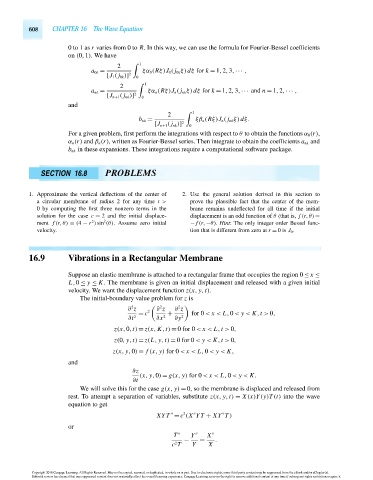Page 628 - Advanced_Engineering_Mathematics o'neil
P. 628
608 CHAPTER 16 The Wave Equation
0to1as r varies from 0 to R. In this way, we can use the formula for Fourier-Bessel coefficients
on (0,1).Wehave
2 1
a 0k = ξα 0 (Rξ)J 0 ( j 0k ξ)dξ for k = 1,2,3,··· ,
[J 1 ( j 0k )] 2 0
2 1
a nk = ξα n (Rξ)J n ( j nk ξ)dξ for k = 1,2,3,··· and n = 1,2,··· ,
[J n+1 ( j nk )] 2 0
and
2 1
b nk = ξβ n (Rξ)J n ( j nk ξ)dξ.
[J n+1 ( j nk )] 2 0
For a given problem, first perform the integrations with respect to θ to obtain the functions α 0 (r),
α n (r) and β n (r), written as Fourier-Bessel series. Then integrate to obtain the coefficients a nk and
b nk in these expansions. These integrations require a computational software package.
SECTION 16.8 PROBLEMS
1. Approximate the vertical deflections of the center of 2. Use the general solution derived in this section to
a circular membrane of radius 2 for any time t > prove the plausible fact that the center of the mem-
0 by computing the first three nonzero terms in the brane remains undeflected for all time if the initial
solution for the case c = 2 and the initial displace- displacement is an odd function of θ (that is, f (r,θ) =
2
2
ment f (r,θ) = (4 − r )sin (θ). Assume zero initial − f (r,−θ). Hint: The only integer order Bessel func-
velocity. tion that is different from zero at r = 0is J 0 .
16.9 Vibrations in a Rectangular Membrane
Suppose an elastic membrane is attached to a rectangular frame that occupies the region 0 ≤ x ≤
L,0 ≤ y ≤ K. The membrane is given an initial displacement and released with a given initial
velocity. We want the displacement function z(x, y,t).
The initial-boundary value problem for z is
2
2
2
∂ z ∂ z ∂ z
= c 2 + for 0 < x < L,0 < y < K,t > 0,
∂t 2 ∂x 2 ∂y 2
z(x,0,t) = z(x, K,t) = 0for 0 < x < L,t > 0,
z(0, y,t) = z(L, y,t) = 0for 0 < y < K,t > 0,
z(x, y,0) = f (x, y) for 0 < x < L,0 < y < K,
and
∂z
(x, y,0) = g(x, y) for 0 < x < L,0 < y < K.
∂t
We will solve this for the case g(x, y) = 0, so the membrane is displaced and released from
rest. To attempt a separation of variables, substitute z(x, y,t) = X(x)Y(y)T (t) into the wave
equation to get
2
XY T = c (X YT + XY T )
or
T Y X
− = .
c T Y X
2
Copyright 2010 Cengage Learning. All Rights Reserved. May not be copied, scanned, or duplicated, in whole or in part. Due to electronic rights, some third party content may be suppressed from the eBook and/or eChapter(s).
Editorial review has deemed that any suppressed content does not materially affect the overall learning experience. Cengage Learning reserves the right to remove additional content at any time if subsequent rights restrictions require it.
October 14, 2010 15:23 THM/NEIL Page-608 27410_16_ch16_p563-610

